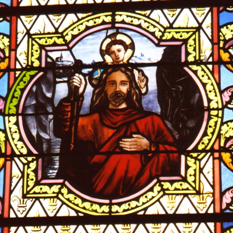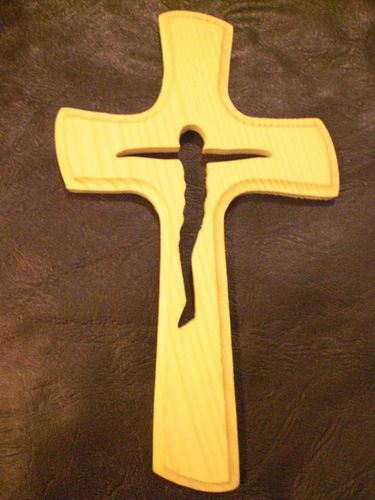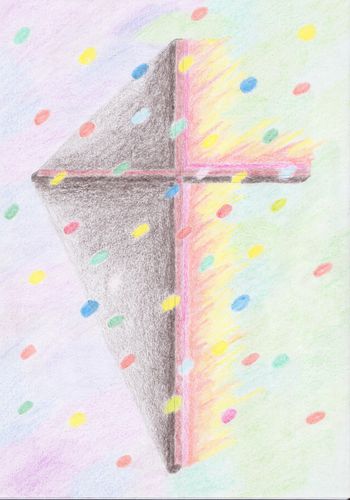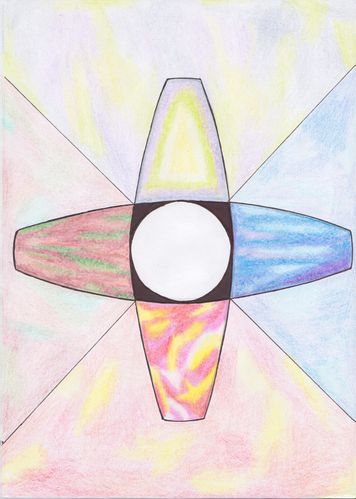The Spiritual Journey of Saint Christopher
‘For when I am weak, then I am strong.’ (2Corinthians 12: 10).
Saint Christopher enjoys a very popular devotion, which is often about blessed medals and rituals especially applied to all kind of vehicles and means of transportations. With a Saint Christopher inside the car, travels will be safe and accidents avoided, seems to say common piety.
But why should it be so? This is a meditation about Saint Christopher, his relevance and message for modern times. Many seem to say that there are great doubts over the life details of Saint Christopher, and indeed we can hardly look for objective biographical notes to enlighten the high level of occurrence related to this particular devotion among common folk. But there might be more than historical accuracy to inspire spiritual life, and the narrative provided by the Golden Legend seems to reveal much more than meet the eyes.
The story of Saint Christopher is not so much about coach or car traveling than it is about a life journey, it is not so much about avoiding accidents than reaching safely the final destination which is nothing else than death. Saint Theresa sometimes called for “seeing the time of life for what it is: a passage towards eternity”. And for this Pasch to be successful, sacrifices are needed, values have to be corrected and humility is to be adopted. That seems to be the magnificent message of Saint Christopher as told by the traditional Golden Legend, through an astonishing set of symbols. After a reminder of the narrative, I propose an exploration of possible significances centered on the evangelical calls to acceptance to one’s ultimate weaknesses and poverty.
The Narrative from the Golden Legend.
Christopher was an enormous Canaanite, of about six meters (12 cubits) high with a terrifying face. He was at the service of the king of the country, and he got the idea to search for the most powerful prince which was in the world in order to serve him. He reached indeed a prince that was said to be the most powerful of all. This prince welcomed him gladly and Christopher was granted residence within the palace. Then, one day, a joker was singing at the presence of the king and as he was doing so, he was frequently naming the ‘devil one.’ And the king who was a devout Christian crossed himself each time he heard the name of the ‘devil one’. Christopher was surprised and finally asked the king what was the meaning of the gesture. As the king refused to tell him, Christopher said: “If you do not tell me, I will leave your service.” Then the king replied: “Each time that I hear the name of the devil one, I protect myself with the sign of the cross, as I am afraid of him, I am afraid that he would hold power over me.” Then Christopher said: “If you are scared of the devil one, then he must be more powerful than you! I bid you farewell because I am going away so to search for the devil one and to offer him my services; I had come here because I had thought that I would have found the most powerful prince of this world!”
Christopher started to search for devil one. He found, within a desert, a great army and the commander in chief was terrifying and ferocious, and he asked him where he was going. Christopher told him: “I am looking for the devil one in order to propose him my services.” And the devil one replied: “I am the one you are looking for.”
Christopher was greatly happy and adopted the devil one as his master. But, as he was traveling with him, they passed in front of a cross on the side of the road. The devil one was greatly scared and bypassed the cross doing a long detour. Christopher was very surprised and asked the devil one what was the cause of this bypassing. Furthermore, he threatened him that he would leave him if left unanswered. Then, the devil one replied: “There is a man called Christ, who was hung on a cross and since then, as soon as I see the sign of the cross, I am afraid and I run away.” And Christopher replied: “If this is so, it surely is because Christ is greater and stronger than you! Then I lost my time with you, and not yet have I found the greater and most powerful prince of the world! I am going to bid farewell to you in order to look for Christ.”
Christopher searched for somebody to help him and finally met a hermit and this one asked him: “The master that you are looking for is requesting you first to fast often.
- May he ask me something else from me, because this very thing, I cannot do. It is beyond my strength!
- He requests you to pray very often.
- Once again, I cannot do this very thing, as I do not even know what it is to pray!
- Then, do you know the river of this country, the one we cannot cross without great danger of death? So tall and strong as you are, would you consent to help people to cross it, it would greatly please the Christ that you are looking to serve, and perhaps he would consent to show himself to you.
- That is something I can do; I promise you to do it in order to serve Christ!”
He then reached the bank of the river, built a hut for him and cut a tree in order to use it as a stick so to help him walk in the river. He carried from one bank to the other side all the people who wanted to cross the river.
As he was sleeping one night in his hut, the voice of a child called him: “Christopher, come and help me cross the river.” Right away, Christopher threw himself out of his hut but found nobody. As he entered back into his hut, once again the voice called him. And again, Christopher did not find anybody. At the third call, he saw a child that requested to help him cross the river. Christopher took the child over his shoulder, equipped himself with his stick and entered into the water. But then, slowly, the waters swallowed them and the child became as heavy as lead. Unceasingly the water became higher and the child heavier, to the point that Christopher thought he would perish. But he succeeded to reach the other side.
Putting the child at rest, he told him: “Ah, my child, you put me in great danger, and you were so heavy on me that it was as if I was carrying the entire world, and indeed if I would have been doing so, it would not have been heavier.” The child replied: “Do not be surprised, Christopher, not only did you carry the entire world, but also the one who created it! I am the Christ, your master, the one you are serving. To prove that what I say is true, put your stick into the ground as you would do for a tree, close to your hut: you will see, tomorrow morning, it will be full of flowers and fruits.”
The child disappeared, but Christopher planted his stick, and rightly enough, the following day in the morning it was transformed into a beautiful palm tree, filled with leaves and fruits.
The Symbolic Wealth of the Narrative
It seems to me that the story hits with a wealth of symbols ordered under a very specific theme, namely ‘strength’ together with its opposite which is ‘weakness.’
Strength, power or might is first what Christopher physically is: a terrifying awesome giant, 12 cubits tall (about 6 meters). 12 is the number of the tribes of Israel, the number of the apostles, therefore carrying an idea of completeness.
And strength or power is what Christopher mentally wants: the obsession for finding and serving the most ultimate powerful king betrays his leading psychological desire. It is easily guessed that Christopher cannot bear to be beaten and put all the chances on his side through service to the most powerful prince. Perhaps the mighty and powerful stronghold that Saint Christopher personifies physically already shows some cracks throughout his restless longing: why should he be so concerned to serve only the most powerful of all, unless there is already, within him the presence of some fear and weaknesses that he is fighting against? But this is already going too fast.
The first prince he serves seems alright. There is a curious switch within the terminology, though first called a ‘prince’ he becomes quickly a ‘king’, therefore indicating the fact that this man does not answer anybody else. That is what Christopher really is looking for: ultimate power and authority, against which nothing and nobody can prevail. Beside, Christopher takes residence within the palace, to further underline the strength of the stronghold. But quickly a problem arises: even this king seems to be afraid of a certain ‘devil one.’ The brief following dialogue betrays a rapport de force that repeats the weakness of the king. Not only is he afraid of the devil one, but Christopher proves himself to be more powerful than him as he compels him to reveal the secret. ‘If you do not tell me I leave you’, as if to say that in truth the person of Christopher is more important than the power of the king! And the following shows that it is so. Christopher can only despise whoever is lower than him!
The meeting with the devil one proves to be no different than the meeting with the first prince, there is no need to repeat myself. Only the presence of the army within the desert is worth noting as it represents alongside the palace another powerful symbol for might. Yet, Christopher cannot be impressed and decides to quit. It is quite surprising however than as Christopher discovers himself more and more powerful as to hold his head high against a king in his palace and against the devil one with his army he is not yet foolish enough as to believe that he is the most powerful one of all. Once again this is an indication of some fainted awareness that weakness is present in his person. A weakness he wants to completely remove.
The meeting with the monk brings some change. The monk does not decline the request but put some conditions, which in effect switch the attention from the outside towards the inside life of Christopher. Tasks are given which in truth, Christopher cannot perform: there is no strength for fasting, he is defeated and he is now, for the first time the weak one. Fasting and praying in truth he cannot do. And these are tasks which are not about physical resources or material danger, but rather about oneself and in relation with the creator. For the first time, Christopher simply accepts that he is weak. Interestingly enough, there is no stubbornness from the monk as other tasks are provided at will, until the counsels for evangelical life, fasting, praying and charity such as they are explained in Matthew 6: 1-8 are exhausted.
As a consequence of having met in truth his weakness, Christopher accepts to change his life. Now, close to the river (and no longer within the dryness of the desert), he dwells in a simple hut, contrasting with the palace of the beginning of the story. It is possible to think here about the work that age brings upon a person: fragility, frailty, weakness of a body that is no longer able to protect safely from internal and external enemies as a palace that is a young, strong and healthy state might do. Moreover, instead of looking for the protection of a mighty army, Christopher equips himself only with a stick, that is the weapon of a usually poor, old or frail person.
Finally, Christopher is asked to perform a strange, mysterious task for which he is called for by night that is the time of dreams. The task is to be repeated three times just as is the call of Samuel (see Samuel chapter 3). Perhaps this is an indication that the child is not so much to be looked for outside but rather, he is to be understood to be already present inside. At the first call, Christopher rushes outside the hut but he finds nobody. The text describes him coming back into his hut but it does not say that he goes out of it again. It is inside the hut which is inside himself that Christopher finds the child and then he is invited to embrace and to carry him.
Who is weaker, frailer and more dependant than a child? The child is the exact opposite of all what was Christopher at the beginning of the story, and of all what he was looking for. The child is small in size as much as Christopher was high or tall. The child is weak and dependant, he needs to rely on a master, to trust his parents and he knows it. This is an attitude that naturally leads towards the welcoming of the values of the kingdom: “Leave the little children, do not prevent them to come to me, that it is to people like them that the Kingdom of Heavens belongs.” (Matthew, 19: 14)
The work that Christopher is asked to perform is first overwhelming: both the waters threaten to overwhelm him and the weight of the child proves to be too much. He feels to be in great danger as it is like “carrying the whole universe.” Indeed, he carries the whole of his universe. For Christopher so much usually relying on strength, the divine work of embracing the child within is of an overwhelming weight. He feels like dying, but what dies in him is a world of power, might and strength, all what he was identified with at first. This is to die in order to come to another birth, to another life.
How can we not think about the work of baptism in this story? The sinking into the waters is like a baptism that is first the burying of the old self within the waters, and then a re-birth to a new life. The resurrection and new life is simply described throughout the miracle of the blossoming stick, the following morning that is the time for the resurrection event. Frailty itself when accepted befriended as a gentle companion becomes fruitful and supportive. It has acquired a capacity to nourish and protect.
The Truthfulness of the Narrative
This legend is true. Yet, it is not a truth about factual history but rather, truth about the life journey of a human being and what is required of him in order to reach the gift of peace, as the unmistakable token for ultimate salvation. Commonly, crossing the river is a symbol for death itself, a passage for new and eternal life. The quest of Christopher prepares him to this last passage that he can perform only when he accepts himself as a child protected only with a hut and a stick.
Christopher is the only giant of Christian tradition that has ever reached sainthood. This is because this giant came to accept his weakness. But the lesson is hard to learn, and at times it was sometimes felt easier to destroy altogether statues of Christopher rather than to struggle with his message. It was the case within cathedrals of Auxerre (France) in 1768 and of Paris in 1788. At the gate of Bern city, the statue of Christopher was eventually transformed into another biblical giant called Goliath. Perhaps these are expressions of denying the transformative work needed in each of us within his or her life time.
So is Christopher to protect us throughout our traveling? Perhaps, but this can not be without accepting to face what he had to, and to do so with great courage. The story of Christopher is a story about a spiritual journey more than car locomotion. It is about humility, trust and accepting one’s own weaknesses rather than about a supernatural protection within vehicles. He is still invoked to protect us from sudden deaths which are nothing more than unprepared ones. Surely enough this is because he shows us a way to prepare ourselves to the great ultimate passage, starting right now.

Saint Christopher as through the stained glass of the Church of Saint Christophe de Chaulieu (Orne). The one who carries Christ is looking like Him!












